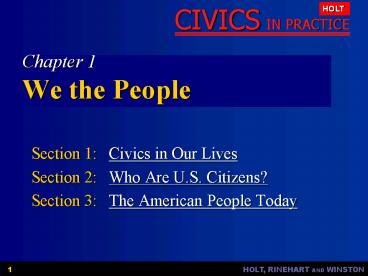Chapter 1 We the People - PowerPoint PPT Presentation
1 / 18
Title:
Chapter 1 We the People
Description:
Title: Chapter 2: Foundations of Government Author: M. C. McLaughlin Last modified by: ITPower Created Date: 8/10/2002 12:25:41 AM Document presentation format – PowerPoint PPT presentation
Number of Views:61
Avg rating:3.0/5.0
Title: Chapter 1 We the People
1
Chapter 1We the People
- Section 1 Civics in Our Lives
- Section 2 Who Are U.S. Citizens?
- Section 3 The American People Today
2
Section 1 Civics in Our Lives
- The Main Idea
- As a U.S. citizen, it is your duty to help
preserve freedom and to ensure justice and
equality for yourself and all Americans. - Reading Focus
- Why do we study civics?
- What are the values that form the basis of the
American way of life? - What are the roles and qualities of a good
citizen?
3
Civics is the study of citizenship and
government. Citizenship includes
Section 1 Civics in Our Lives
- Being a productive member of society
- Fulfilling the duties and responsibilities of a
citizen
4
Ideals of the U.S. government and the American
way of life
Section 1 Civics in Our Lives
- Freedom and equality are protected by laws.
- Citizens share in protecting liberties.
- Citizens are guaranteed an education and equal
opportunity of employment. - Citizens must respect the rights of others.
5
Some roles and qualities of a good citizen
Section 1 Civics in Our Lives
- Voting
- Government or political participation
- Informing officials of needs or disagreements
- Studying civics to understand the government
- Respecting the rights of others
- Responsibly using natural resources
6
Section 1
Question What ideals form the basis of the U.S.
government and the American way of life?
American Ideals
- Freedom
- Equality
7
Section 2 Who Are U.S. Citizens?
- The Main Idea
- Throughout history, immigrants have brought their
languages, ideas, beliefs, hopes, and customs to
the United States. Their ways of life are
constantly mixing with and influencing the
culture of Americans who came before. - Reading Focus
- Who are Americans, and from where did they
come? - What changes have occurred in U.S. immigration
policy since the early 1800s? - How does a person become a U.S. citizen?
8
North Americas earliest inhabitants
Section 2 Who Are U.S. Citizens?
- People from Siberia settled in North America
12,00040,000 years ago. - A.D. 1000Vikings arrived but did not settle in
North America. - 1492Christopher Columbus claimed land for Spain.
- Spanish, French, British, Dutch, Swedish, and
Africans (slaves) settled in America.
9
Changes in U.S. immigration policy
Section 2 Who Are U.S. Citizens?
- 1880srestrictions placed on immigration in
response to wage issues - 1920sLimits on yearly immigration quotas set
for particular countries - Immigration Act of 1990cap set at 675,000
immigrants per year - Refugees are not subject to the immigration cap.
- 1986Immigration Reform and Control Act
10
How U.S. citizenship benefits people
Section 2 Who Are U.S. Citizens?
- Freedom is protected by laws.
- Citizens are eligible for government services.
11
Section 2
Question What are the benefits of U.S.
citizenship?
12
Section 3 The American People Today
- The Main Idea
- The U.S. population continues to grow and change
today. - Reading Focus
- Why is the census important?
- In what ways does population grow and change?
- What has changed about the American population
over the years? - For what reasons have Americans moved and settled
in new areas over the course of U.S. history?
13
Census Information
Section 3 The American People Today
- Determines how many people each state has in the
House of Representatives - Shows population growth and decline for different
areas - Reports how many children each family has
- Helps government, businesses, and individuals
plan for the future
14
Section 3
Question Why is census information important?
Who Uses It
How They Use It
government
to plan the budget
to fill the needs of the market
businesses
to write books and reports
individuals
15
Populations grow by
Section 3 The American People Today
- Natural increase
- Adding new territories
- Immigration
16
Changes in the movement of Americans
Section 3 The American People Today
- The first census found the majority of Americans
living on farms and rural areas. - 1830urban areas were growing faster than rural
areas - 1920more Americans lived in cities than in rural
areas - Mid-1900ssuburbs developed around crowded cities
- Today there are more people living in suburbs
than in cities. - Migration to the Sunbelt increased during the
1980s1990s.
17
SECTION 3
Minority Group Conditions / Concerns
African Americans making gains toward equality, but statistics still show members are lagging in education, employment, and income becoming more politically active
Hispanics rapidly growing population trailing in income and education diverse population
Asian Americans contrast between first-generation immigrants, who are often poor, and second-generation, many of whom succeed educationally and financially viewed as "model minority," although this term is resented
American Indians often live on reservations high poverty and poor education encouraged to assimilate taking steps to establish sources of income and better schools
White Ethnics includes some who assimilate quickly and others who remain victims of prejudice and discrimination making gains in religious tolerance good education level
18
Chapter 1 Wrap-Up
1. Why do people study civics? 2. What principles
and ideals form the foundation of the American
system of government? 3. How has U.S. immigration
policy changed since the early 1800s? 4. What
benefits do people derive from being a citizen of
the United States? 5. Identify three ways that
the populations of countries increase. 6. How
have migration patterns shifted from the 1800s to
the present?































